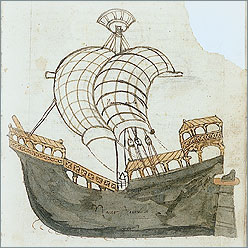Ships and Shipbuilding: Sailing Ships
Michael spent much of his career sailing in commercial galleys, but most commercial goods in his day were carried in ships powered by sail alone. While galleys were built in the Venetian state Arsenal and managed by the Venetian Senate, most sailing ships were privately built, owned and operated. Michael's inclusion of kinds of ships he may never have sailed on demonstrates that his interests went well beyond the practical knowledge that he used in his everyday life. Michael describes two of these sailing ships: a lateen-rigged ship and a square-rigged ship. Both vessels reflect elements of the evolution of the ship during what has come to be called the Nautical Revolution of the Middle Ages.
A major feature of this "revolution" was the marriage of new ship technologies from the Atlantic coasts with the existing technologies of the Mediterranean. This process began when shipwrights in the South adopted, then adapted, a Northern European kind of ship known as a cog. The cog was much larger than southern shipwrights were used to building. It had a flat floor and wide beam that provided plenty a large cargo space and very high sides that made it easier to defend. A cog was normally equipped with a stern rudder and carried a square sail on a single mast. Its hull was clinker-built, meaning that planks on the outside overlapped each other in much the same way one can still see on an old wooden rowboat. Most of the strength of the hull in clinker-built ships resided in the shell created by the planking. Internal frames were used to reinforce the planks rather than provide a structural foundation. Scholars refer to this kind of ship as "shell-built."
When Mediterranean shipbuilders began to build cogs in greater numbers after 1300, they borrowed the cog's large dimensions and the stern rudder, abandoning the steering oar in use until then. But they applied their own construction techniques. In particular, they used the Southern European "frame-built" technique. Using this method of construction, the strength of a ship's hull is provided by its internal skeleton, and the planks are basically used to make the framework watertight. During construction, the frame was erected first and then planked over, but the planks were placed edge to edge and did not overlap. This edge-planking technique came to be called "carvel." This word would soon evolve into "caravel," the name given to the Spanish and Portuguese ships that led the way in the Age of Discovery.
As with the ship, so with the sails. The square sail favored in the north was adapted for use alongside the lateen sail favored in the south. New and different sail plans came into use on different kinds of ships. (Learn more about sails and rigging.)
On both fronts, Mediterranean developments during the 14th and 15th centuries outran those of Northern Europe. As a result, although Michael's sailing ships might seem somewhat ordinary to us, and even a little dull compared to his galleys, they would have been seen as examples of the very latest technology to many mariners and shipwrights from the Atlantic.
Nave latina
The first sailing ship Michael describes is a nave latina, by which he meant a ship equipped with lateen sails (164b-168a). Most Venetian goods were carried in this kind of single-deck vessel. Its two masts would have been relatively common in Venice, but unusual in Atlantic waters. In England, for example, mariners were only just beginning to build ships with two masts for commercial purposes.
As with the galleys, Michael began by providing basic dimensions:
| Dimension | Venetian measures | Meters | U.S. feet |
|---|---|---|---|
| Length on the deck | 12 paces | 18.61 | 61.06 |
| Breadth | 24 feet | 8.41 | 27.58 |
| Height | 9.5 feet | 3.33 | 10.92 |
As these measurements show, the nave latina was considerably shorter than a commercial galley and much rounder in shape. This made it a good bulk-cargo carrier.
Michael does not give detailed measurements of the hull. Instead, his description is brief and reflects a different approach to design and construction when compared with his text on galleys.
Rather than dwell on the hull, Michael includes a few details about the stern rudder and ship's boats, and then pushes immediately on to a discussion of what was most important—namely, the rigging and sails for the two masts.
One element of Michael's description of the nave latina is very noticeable. He left large spaces in the text for illustrations and even included labels stating where different pictures should go. Unfortunately, none of these illustrations were ever made.
Nave quadra
The second sailing ship Michael describes is a nave quadra, which he repeatedly refers to as a chocha, or cog (168b-182b; ![]() 182b). The word "cog" reflects the Atlantic origins of this kind of high-sided vessel. The word "quadra" refers to the square sail it carried.
182b). The word "cog" reflects the Atlantic origins of this kind of high-sided vessel. The word "quadra" refers to the square sail it carried.
This ship would have seemed doubly advanced in Atlantic waters. Not only did it have two masts; it also carried a square sail on the mainmast and a lateen sail on its mizzenmast.
Michael's description of the nave quadra begins with the following dimensions:
| Dimension | Venetian measures | Meters | U.S. feet |
|---|---|---|---|
| Length on the deck | 13 paces | 20.16 | 66.15 |
| Breadth | 27 feet | 9.46 | 31.02 |
| Height | 14 feet | 4.90 | 16.09 |
As these measurements show, the nave quadra was bigger than the nave latina, but still much smaller and rounder than a commercial galley.
As with the nave latina, Michael skips further details about the dimensions of the hull. He offers a few details about the size of the masts and yards, followed by brief comments on the ship's boats.
As Michael seems to realize, the most important thing about the nave quadra was its sail plan and rigging. The text offers page after page of detailed dimensions concerning the shrouds, stays, and myriad other lines.
As with the nave latina, Michael left spaces in the text for illustrations and labeled the spaces with the drawings he would include. All but one of those illustrations are missing. The one drawing shows the nave quadra under sail, curiously depicting only one mast, with one square sail.












